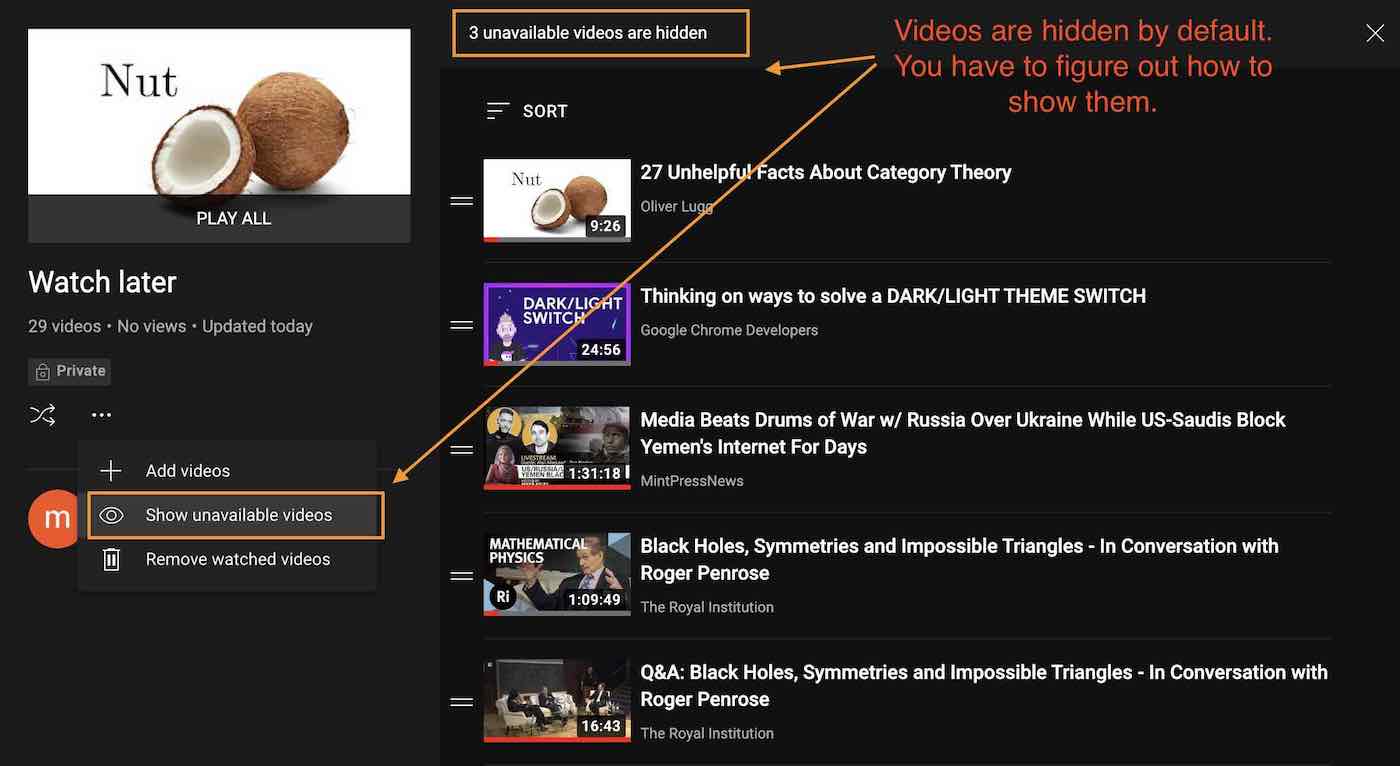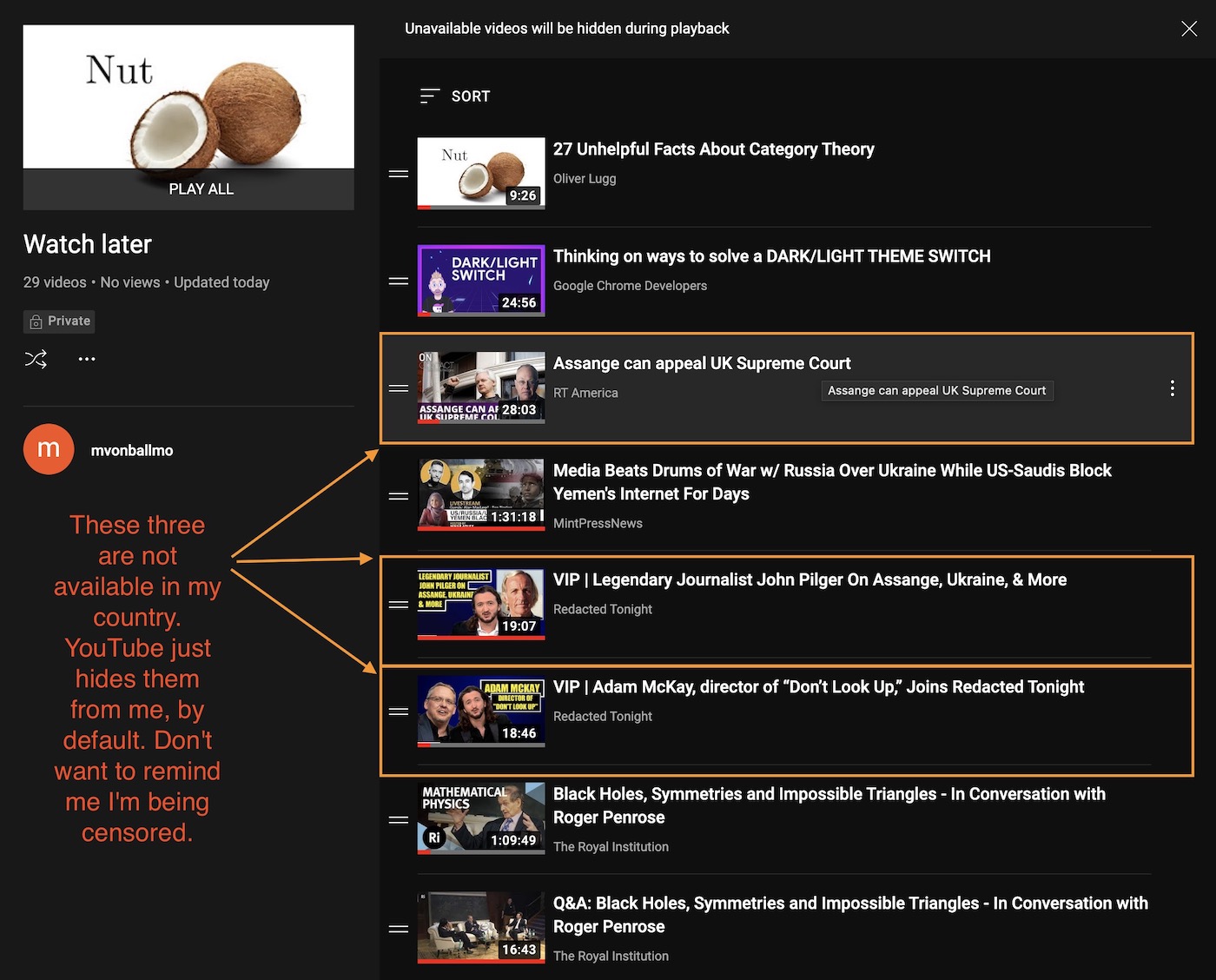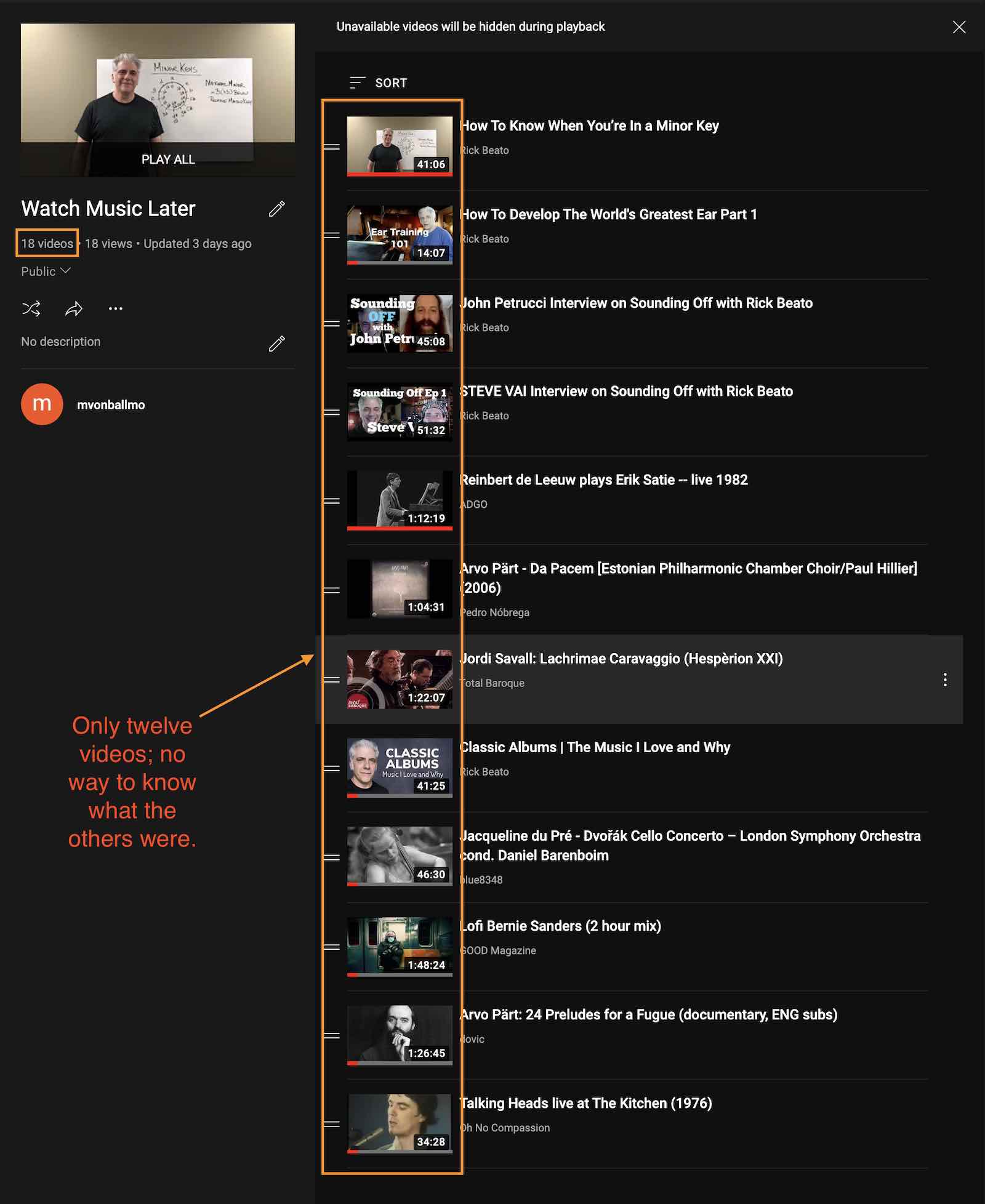Soft Censorship on YouTube
Published by marco on
YouTube doesn’t actually remove videos from your lists. I suppose that makes them better than truly totalitarian systems, which would make a greater effort to erase knowledge. Instead, when a video is unavailable, YouTube automatically hides it from you, removing its pesky presence from your lists, replacing these videos with a subtle notification at the top of the list.
 Unavailable Videos In Watchlist
Unavailable Videos In Watchlist
If you’ve got more than a couple of dozen videos in a list, then you’ve probably scrolled down far enough in the list that you cannot easily see the notification.
That’s what happened to me when, in late February, RT was taken off-line, censored into oblivion by a holier-than-thou Western world, high on its sense of self-satisfaction. I only recently discovered that there were videos in my “Watch Later” list that I’d meant to watch months ago, but that YouTube had decided, in its gentle and all-knowing benevolence, to help me forget about.
 Videos Available but not Watchable
Videos Available but not Watchable
I had to dig them back from YouTube’s clutches. Obviously, I could no longer watch them—that would be madness!—but at least I could copy the titles to search for the videos on platforms either don’t censor content or, at least, aren’t censoring that particular content.
If I refresh the page, the “unavailable” videos are, once again, hidden. This cannot be anything but deliberate. The content is still technically available—OMG not as bad as China or, God help us, Russia—but it’s still out of reach of most people, so it will, effectively, be censored.
The blocked videos are interview shows, with well-known and renowned journalists. They’re just collateral damage in the holy war for global domination. Oops. Just a coincidence that true-left, anti-war voices were accidentally removed from YouTube. All of the war-hawking bullshit from mainstream, acceptable sources driving the desired narrative continue to be available in full HD (looking at you, CNN). If you want to hear about how we should go to WWIII over Ukraine, you can fill your whole weekend. Thanks, YouTube, for trying to help me get my mind right.
The following video is an interview with the legendary journalist and documentary filmmaker John Pilger by Lee Camp. They made the mistake of holding the interview on RT, which means that nearly no-one in the western world will ever find it again, as was surely the intent. Some may call this “collateral damage”, but it can hardly be a coincidence that anti-war voices are consistently pressed to the margins—and then erased from those as well.
VIP | Legendary Journalist John Pilger On Assange, Ukraine, & More by Lee Camp / Redacted Tonight (YouTube)
You can watch the video above[1] at Legendary Journo John Pilger by Lee Camp / Redacted Tonight on January 28, 2022 (Portable.TV).
The next interview is also by Lee Camp, this time with Adam McKay, the director of “Don’t Look Up”. There is literally no non-ideological reason (e.g. RT BAD) why this video is banned.
VIP | Adam McKay, director of 'Don’t Look Up,' Joins Redacted Tonight by Lee Camp (YouTube)
You can watch the video above at Adam McKay! by Lee Camp / Redacted Tonight on February 4, 2022 (Portable.TV).
Also, once you no longer have a direct link to the video, you will never find it again. I was going to link to one of Chris Hedges’s last On Contact shows on YouTube, which has likewise disappeared, but I’d already removed the link from my “Watch Later” list. Now, even if I enter the title directly into YouTube’s search, it doesn’t appear. It’s also not in my “Watch History”.
That’s moving a bit beyond “soft” censorship, but perhaps I’m being too sensitive. I’m sure there are those who could defend this behavior as being materially different from what China does, but I’m skeptical I’d be willing to entertain such an argument.
At any rate, you can watch Hedges’s interview with John Pilger at On Contact: Assange can appeal UK Supreme Court by Chris Hedges on January 26, 2022 (RT).
Yes, you saw that correctly: now you can only watch Chris Hedges interview on RT—and most people reading this article won’t be able to watch videos there, either, because their countries are blocking the Russia Today domain name entirely. That’s all in the name of freedom, of course. Wave that flag. We have to protect people’s brains from getting the wrong ideas. This is not to say that RT isn’t spreading propaganda—it most certainly is—but that people should be able to decide for themselves.
Banning RT doesn’t stop propaganda; it simply amplifies the remaining propaganda that hasn’t been blocked. For example, you can still watch the full compendium of content provided by CNN. You can inhale every breathless and uncritical recitation of every word that comes out of Zelenskyy’s mouth as if it were the unalloyed truth, as if to ask for evidence were an affront to all that is good and holy on Earth. But at least RT is gone.
Portable and Rumble
Portable.TV is good at streaming videos but, like another recent video platform, Rumble, isn’t quite as useful a research tool as YouTube. In particular, neither Portable nor Rumble allows playlists (e.g. “watch later”). You also don’t have auto-captions or scrubbing with the arrow keys. The user experience on YouTube has become quite good for research. More’s the pity that they’re so aggressively censoring content.[2]
Portable has particularly terrible navigation and direct-linking to videos (everything is done with just JavaScript). It’s quite frustrating. The only way I’ve found to get a direct link is to “share” the video via email and then copy the link from the generated mail.
Portable does not support embedding and Rumble supports it only through an iframe or direct JavaScript (instead of allowing the video element, like YouTube does).
No-one has the right to host videos on YouTube, but we should be concerned nonetheless when the primary means of hosting videos online—nearly the only, near-monopolistic place—wields such strong editorial control. Especially when it’s done to such starkly political purpose.
I’ve recently discovered that my company’s internal network works with YouTube to block certain videos, presumably those that might contain—GASP! 😱—curse words. For example, this video does not appear in the “Restricted Mode” enforced on that network,
Best of The Cancel | Trip Hop & Boom Bap & Abstract Hip Hop by S!X (YouTube).
Or maybe it’s because the poster shows a woman smoking a joint? It’s an hour and twenty minutes of trip-hop audio. The poster doesn’t change. This is not offensive by nearly any sane measure.
In restricted mode, the video-blocking is even more aggressive:
 YouTube Blocks Everything In Restricted Mode
YouTube Blocks Everything In Restricted Mode
The screenshot above was taken from my private desktop at home, with “restricted mode” enabled manually.
This is somewhat different behavior than I observed when YouTube was working hand-in-hand with the corporate network. I went back to the corporate notebook but now have access to those music streams, even with ZScaler enabled. Whereas before I was unable to toggle the “restricted mode” and have it “stick”, now I’m able to do so. I’m also not in the office, so maybe there’s something different between the office network and the “extended office network” enabled by ZScaler.
I’m not quite sure what’s going on, but now I’m loath to manually enable restricted mode on my work laptop, lest I lose access to my now-available music playlist. 🤷♀️
↩